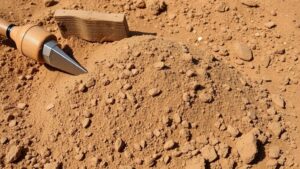How to Identify Rock Formations That Trap Gold Deposits
How to Identify Rock Formations That Trap Gold Deposits
Identifying rock formations that trap gold deposits requires a blend of geological knowledge, field experience, and an understanding of mineralization processes. This article aims to provide a comprehensive guide to understanding the types of rock formations that commonly harbor gold, the geological features to look for, and practical methods for identification.
Understanding Gold Deposits
Gold is typically found in two main types of deposits: lode and placer deposits. Lode deposits are primary sources where gold is found in rock, while placer deposits are secondary sources created through mechanical weathering and erosion. Understanding these two types is essential as each is associated with specific geological formations.
Geological Settings Favorable for Gold Deposits
The geologic settings most favorable for gold deposits include:
- Quartz Veins: Gold is often found within quartz veins and associated with other sulfide minerals. Regions with significant quartz vein systems, such as the Sierra Nevada in California, are prime candidates for gold prospecting.
- Greenstone Belts: These ancient volcanic and sedimentary formations are rich in gold-bearing mineralization. The Abitibi Greenstone Belt in Canada is one of the largest gold districts in the world.
- Granitoid Intrusions: Gold is frequently associated with granitoid intrusions that have undergone hydrothermal alteration. Carlin Trend in Nevada is a prime example, hosting numerous open-pit mines.
- Alluvial Deposits: Rivers can concentrate gold into alluvial deposits, often found near the mouths of rivers where sediment accumulates. The Klondike region in Yukon, Canada, is a historic example of rich alluvial gold deposits.
Desirable Geological Features
When analyzing rock formations for gold potential, certain geological features are indicative:
- Fault Zones: Faults can create pathways for mineral-rich fluids, leading to gold deposition. Identify zones of increased fracturing and alteration along faults.
- Favorable Rock Types: Look for sedimentary rocks like conglomerates, as well as metamorphic formations. e may contain gold within their matrix or as veins.
- Oxidation Zones: Areas where sulfide minerals have oxidized can create conditions favorable for gold precipitation. Observing changes in mineral colorations can help identify these zones.
Field Identification Techniques
Detection and exploration techniques play a critical role in identifying potential gold-bearing rock formations:
- Geological Mapping: Detailed mapping of an area can reveal the relationships between different rock types and structures, which is crucial for identifying gold traps.
- Geochemical Sampling: Soil and rock samples can be analyzed for gold content. High concentrations of arsenic may also indicate proximity to gold deposits.
- Geophysical Surveys: Techniques such as magnetic and resistivity surveys can identify structures associated with gold deposits without extensive excavation.
Case Studies and Real-World Applications
Several successful gold mining operations showcase effective identification of gold-trapping formations. Super Pit in Kalgoorlie, Australia, exemplifies a successful transition from initial geological surveys to detailed underground mapping that revealed substantial lode deposits. Similarly, the Chirano Gold Mine in Ghana utilizes both geochemical sampling and geological mapping to identify potential reserves.
Actionable Takeaways
For prospectors and geologists aiming to identify rock formations that trap gold deposits, the following are key strategies:
- Focus on areas with known geological features associated with gold deposits, such as quartz veins and greenstone belts.
- Use both surface and subsurface exploration techniques, including geological mapping and geophysical surveys.
- Incorporate geochemical analysis to refine exploration efforts and enhance the likelihood of successful discoveries.
By understanding the complex interplay between geological formations and gold mineralization, individuals can better target their exploration efforts, increasing the chances of finding valuable gold deposits.



